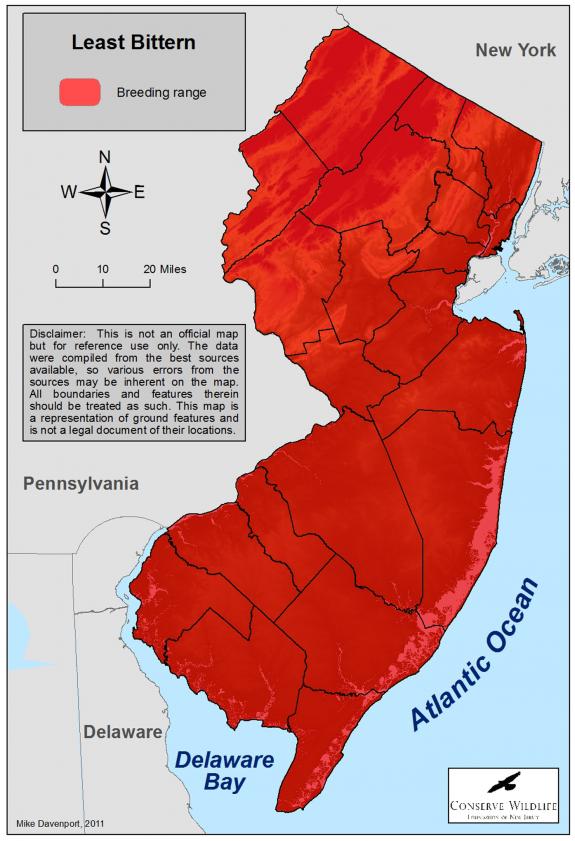Ixobrychus exilis
Type: bird
Status: special concern
Species Guide
Least bittern
Ixobrychus exilis
Species Type: bird
Conservation Status: special concern
IDENTIFICATION
The least bittern is the world’s smallest heron with a length of 13 inches and a wingspan of 17 inches. It is a stocky, small-sized wading bird. The neck is buffy-white with brown streaking. Their belly is white while the upper portion of their body, their crown, and tail are black on males and dark brown on females. There is also a large bright buff wing patch. Their eyes and bill are yellow while their legs are greenish-yellow.
Like its larger cousin, the American bittern, it lives in marshes with dense vegetation. They have thin bodies. This allows them to move easily through thick reeds and grasses. Their camouflaged feathers and shy behavior often allow them to go unnoticed. When frightened, bitterns take on a reed-like position. They point their head skyward and move their body back and forth, imitating a blade of grass blowing gently in the breeze.
Bitterns fly with stiff, laboring wing beats that are quicker than other herons. Bitterns fly low with their legs trailing behind the body.
Least bitterns may be quite vocal, both during the day or at night. The male’s call is a soft coo-coo-coo. Other calls include a rail-like tut-tut-tut or kek-kek-kek-kek which can be heard year-round.

Distribution & Habitat
The least bittern is a widespread species with a large breeding range consisting of the entire eastern half of the U.S. as well as several additional local sites as far west as California and Oregon. It winters in portions of Mexico and Central America and is a year-round resident in southern Florida, the Caribbean, Mexico, Central America, and portions of South America as far south as northern Argentina.
Least bittern habitat is largely tall emergent vegetation within freshwater marsh, although they may occasionally occupy coastal brackish marsh as well. They will use artificial wetlands as well as wetlands near lakes, rivers, or estuaries. During migration or in winter, bitterns may be found in wetlands, marshes, and grassy fields.
Diet
Least bitterns prey on small fish, amphibians, mollusks, crustaceans, insects, and some small mammals.
Hidden by its camouflaged feathers, the bittern stalks prey, standing motionless before striking with its spearlike bill. Bitterns hunt alone. They search for food within marshes or along the shorelines of creeks during the day or at night. They may also cling to reeds and other emergent vegetation in order to forage over deeper water.
Life Cycle
The breeding season for the least bittern in New Jersey is between mid-May and late August. A platform nest is built in a dense stand of emergent vegetation over shallow water, about a foot above the water. Both sexes construct the nest out of dried plants among live stalks. 4 to 5 eggs, sometimes as many as 7, are laid in May or June and incubation lasts 16 to 19 days. The young are semi-altrical and are tended to by both parents. The young can leave the nest 4 to 5 days after hatching but normally leave at 13 to 15 days. They are capable of flight at 25 days after hatching.
Current Threats, Status, and Conservation
The least bittern has undergone a decline in population over the last several decades throughout some portions of its range including New Jersey. Such declines are most likely due to loss of wetland habitat. It is listed as a Species of Special Concern in New Jersey (not yet endangered or threatened but possibly on its way).
Wetland destruction has occurred at an alarming rate in New Jersey, destroying wetlands critical to breeding bitterns. Like many species in the state, protecting bitterns is closely tied with protecting their wetland habitats. Strong environmental laws to protect wetlands from disturbance and development help to protect wetlands as well as bitterns.
Because of the secretive nature and patchy distribution of least bitterns, we still have much to learn about their biology and population status. Research needs to be completed to find additional breeding sites, check existing nesting areas, and determine their population status within the state.
References
Text written by Michael J. Davenport in 2011.
Scientific Classification
- Kingdom: Animalia
- Phylum: Chordata
- Class: Aves
- Order: Ciconiformes
- Family: Ardeidae
- Genus: Ixobrychus
- Species: I. exilis